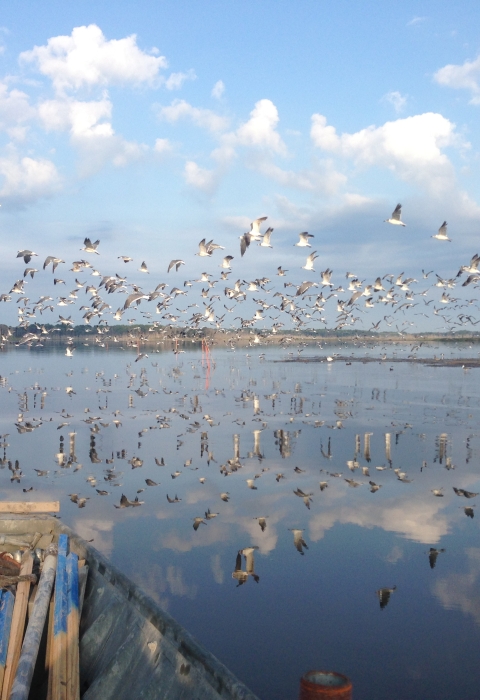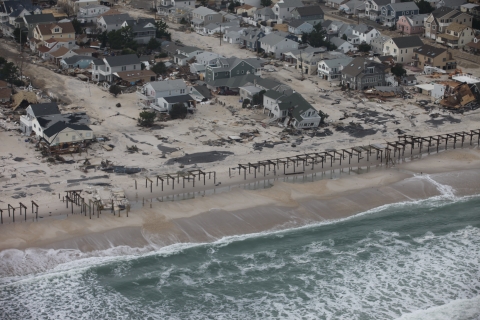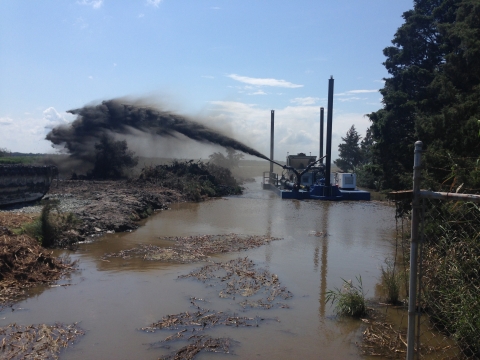By most books, hurricane season starts on June 1, but the U.S. Fish and Wildlife Service has been preparing landscapes to rebound from a superstorm for more than a decade.
Bolstering the resilience of coasts so they’re able to withstand storm surge is a cornerstone of our work conserving, protecting and enhancing habitats for people and wildlife. When Hurricane Sandy hit the Northeast coast in 2012, it sounded the alarm on how crucial it is to prepare our coastal communities for a changing climate and heightened storms.
With a slew of critical federal funding for Hurricane Sandy recovery, we rolled out a series of projects to not only rebound from the storm but to strengthen ecosystems into the future.
Those projects set in motion lasting landscape-scale changes — so that all parts of interlocking ecosystems are considered, across state lines and habitat-types — that will benefit communities and wildlife for decades. But the impacts of such work transcend their immediate surroundings.
Drawing upon the lessons we learned from Sandy recovery work, we hit the ground running with robust coastal resilience efforts when massive funding arrived through the Bipartisan Infrastructure Law Bipartisan Infrastructure Law
The Bipartisan Infrastructure Law (BIL) is a once-in-a-generation investment in the nation’s infrastructure and economic competitiveness. We were directly appropriated $455 million over five years in BIL funds for programs related to the President’s America the Beautiful initiative.
Learn more about Bipartisan Infrastructure Law and the Inflation Reduction Act. Together, the funding sources allow us to continue important work that will help communities and habitats rebound when the next storm hits.
Sandy work provided a critical foundation for future projects. We laid the groundwork for future partnerships and set a standard for delivering on projects at the scale of entire landscapes. We've proven the effectiveness of working with natural patterns and dynamics, allowing us to plan ahead for future climate conditions (rather than historical ones).
Prime Hook's Precedent
Consider one of the largest marsh restoration efforts on the East Coast at Delaware’s Prime Hook National Wildlife Refuge.
When Hurricane Sandy struck in 2012, its storm surge breached the refuge’s coastal freshwater impoundments — 4,000 acres of would-be salt marsh salt marsh
Salt marshes are found in tidal areas near the coast, where freshwater mixes with saltwater.
Learn more about salt marsh managed to keep out the tide. With Sandy, floods washed out the landscape and drowned vegetation.
Instead of rebuilding the impoundments, managers returned the system to its naturally occurring marsh system.
In 2015, construction teams dredged sediment out of drainage channels to foster natural tidal flow, emptying the freshwater impoundments and inviting back salt marsh conditions. They used that dredged sediment to build back beach and dunes that the storm had washed out. The beach invites natural over wash and is large enough to absorb big influxes of water.
Sediment was also added to build up marsh surface height, and the system now absorbs storm surge, large and small. The absorbent marsh protects the nearby Prime Hook Beach access road from the frequent flooding that occurred with the large impoundments.
“This place is like a field of dreams for restoration,” says Bart Wilson, restoration project manager. “The eel, the alewife and the piping plover are here. Restore the ecosystem, and everything benefits. They will come.”
Lessons Laying a Foundation for the Future
Enter a key lesson of Sandy recovery work: refuge managers used state-of-the-art science and modeling to envision and design a coastal environment that could withstand a future of more-frequent intense storms predicted with a changing climate; they restored the whole ecosystem, rather than just isolated parts of it.
Sandy funding gave us a wide-angle lens to look at salt marshes holistically and coordinate our regional conservation efforts. More than $2 million went to a comprehensive assessment — of water levels, fish and marsh-dependent birds, vegetation cover, and more — of salt marshes on 15 Northeast national wildlife refuges.
A separate effort was dedicated to researching the storm’s effects on salt marsh birds and salt marsh restoration efforts. In places with healthy marsh, the storm had little effect on the nesting success of saltmarsh sparrows and seaside sparrows — two of our priority species most threatened by climate change climate change
Climate change includes both global warming driven by human-induced emissions of greenhouse gases and the resulting large-scale shifts in weather patterns. Though there have been previous periods of climatic change, since the mid-20th century humans have had an unprecedented impact on Earth's climate system and caused change on a global scale.
Learn more about climate change and rising sea levels— in the years following the storm.
“Major storms likely aren't a big problem for coastal birds, probably because coastal marshes are resilient to those dynamics,” says Mo Correll, science coordinator for the Atlantic Coast Joint Venture. “The caveat is that those marshes need to be intact and functioning in order to efficiently absorb storm impacts into the future.”
Such research directs where we should prioritize and pursue future work — then, when funds arise to support that work, we can hit the ground running.
Nowhere is this more vivid than in the work of the North Atlantic Aquatic Connectivity Collaborative (NAACC), which, using Sandy funds, developed a database that houses information on road-stream crossings assessments to help identify and prioritize sites for restoration.
When the Bipartisan Infrastructure Law provided funding for our National Fish Passage Program — to remove stream barriers, like dams and undersized culverts — we were ready with NAACC’s identified priorities. In 2023, more than $7.5 million of that went to six projects in our Northeast region — some of which grew out of what the NAACC database identified. The funding from superstorms of the past is actively preparing us for those of the future.
A case for connectivity
One project in Maryland directly used information from the NAACC database to identify priority sites for restoration. Through BIL funding awarded this year, the Service and our partners will remove 8 barriers — dams and culverts — and open 30 miles of stream in Maryland’s North Branch Potomac River (NBPR) watershed, to connect habitat for Eastern Brook Trout. It underscores that resilience occurs at a landscape-scale, from headwaters to coast.
The NAACC highlighted road-stream crossings that were barriers to fish passage fish passage
Fish passage is the ability of fish or other aquatic species to move freely throughout their life to find food, reproduce, and complete their natural migration cycles. Millions of barriers to fish passage across the country are fragmenting habitat and leading to species declines. The U.S. Fish and Wildlife Service's National Fish Passage Program is working to reconnect watersheds to benefit both wildlife and people.
Learn more about fish passage . Removing them will build community resilience and enhance trout habitat. Several projects will meet the infrastructure maintenance needs of disadvantaged communities, keeping them safe from floods, while reconnecting trout spawning habitat to the mainstem river.
River connectivity projects like this show that coastal resilience doesn’t stop at the coast; dams can pose a flood risk to surrounding communities when storms trigger freshwater flooding. Updating culverts and removing dams is as much a part of protecting people from storms as bolstering shorelines is.
A leading legacy
Sandy taught us we need a natural fortress to match the natural forces of nature. Working with landscape dynamics and embracing natural infrastructure — things like dynamic beaches and absorbent salt marshes that can receive storm surge better than concrete sea walls — will make the most resilient coastlines. Planning these projects at the landscape-scale is another essential lesson we carry forward as we plan future resilience projects through two new funding sources.
We’re restoring coastal wetlands to guard against storm surge and sea-level rise, benefit at-risk species like the saltmarsh sparrow, and protect important natural carbon-storage abilities.
Hurricane Sandy left an indelible imprint on the Atlantic Coast, but it also created new opportunities to learn, collaborate with partners and improve our conservation approaches. Now, we face increasingly severe storms with the wind at our back due to new funding sources and a clear path toward a more resilient future.





